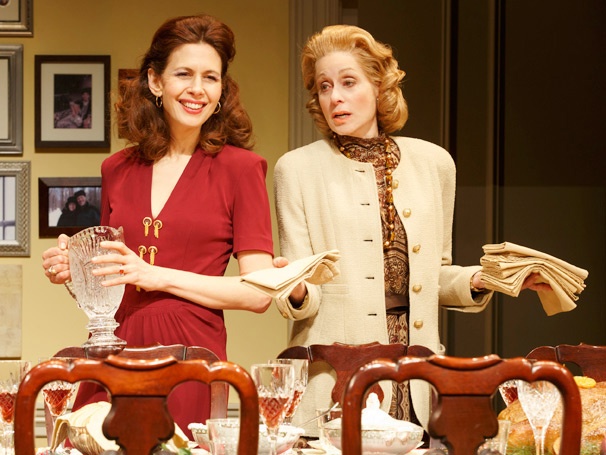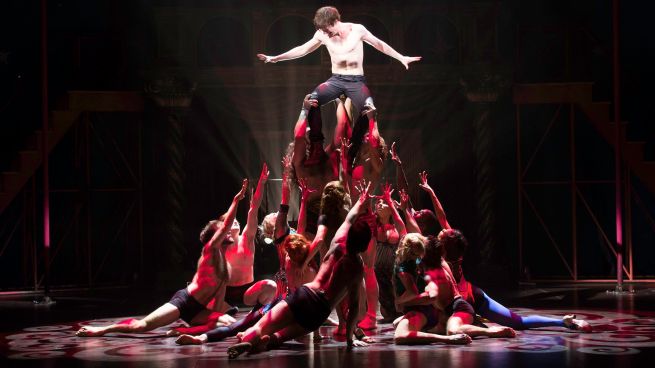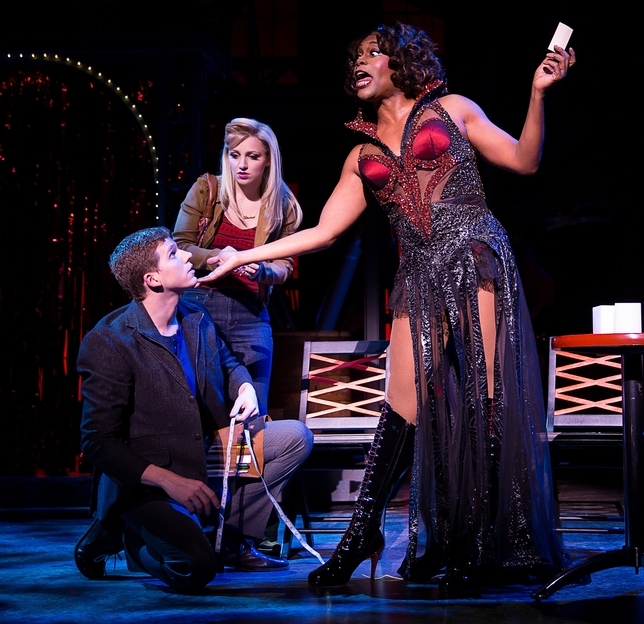Welcome
back! With the announcement of the 2013
Tony nominees less than 24 hours away, I’m back to make some predictions about
which leading actors and actresses will be waking up to very good news tomorrow
morning. As a disclaimer, I should point
out that I have by no means seen all the eligible shows, and in some cases I’m
basing my predictions primarily on hearsay and gut instincts.
Here are my
predictions:
Best Actor in a Musical
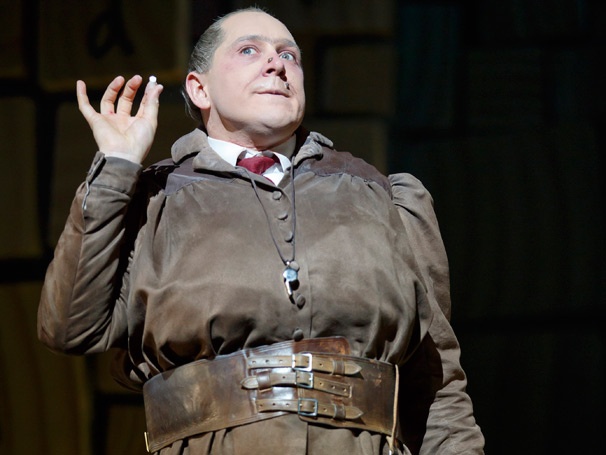 |
| Olivier Award winner Bertie Carvel, reprising his work as Miss Trunchbull in the Broadway production of Matilda |
They say it
takes a real man to do drag, and coincidentally I think the frontrunners in
this category are the two men doing so nightly on the Great White Way. As drag queen Lola, Billy Porter is the
sequined heart and soul of the delightfully frothy Kinky Boots, and his assured performance will definitely land him
among this year’s nominees. His biggest competition
comes from Bertie Carvel’s scene-stealing turn as the wicked headmistress Miss
Trunchbull in Matilda, a role which
has already netted Carvel an Olivier Award and plenty of praise.
Elsewhere,
Rob McClure can rest assured that his complete transformation into Chaplin’s titular character will propel
him to Tony recognition, as he was the one bright spot in an otherwise dreary
production. Anthony Warlow deserves
special recognition for bringing a depth and humanity to Annie’s Daddy Warbucks few thought possible, and a nomination is
most likely in his immediate future. And
for the final slot, Pippin's Matthew
James Thomas has the enviable advantage of playing the title character in one
of the spring’s artistic zeniths, and the massive amount of love for the show
should propel him all the way down the red carpet on Tony night.
I don’t
foresee much chance of anyone unseating one of the above five actors, which is
a shame for both Jim Norton – whose Chairman in The Mystery of Edwin Drood was a master class in comedic timing –
and Stark Sands, who does great work with the less flamboyant of Kinky Boots’ two male leads. If one of them were to sneak into
competition, my money would be on Norton, as I don’t think Sands is on equal
enough footing with Porter to force the Tony committee to nominate both of them.
Nominees:
Bertie
Carvel, MatildaRob McClure, Chaplin
Billy Porter, Kinky Boots
Matthew James Thomas, Pippin
Anthony Warlow, Annie
Runner-Up: Jim Norton, The Mystery of Edwin Drood
Best Actress in a Musical
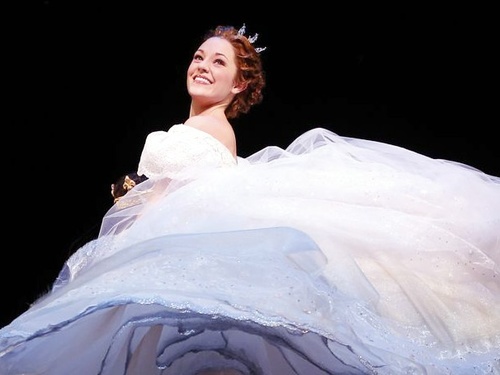 |
| Laura Osnes steps out of "her own little corner" and into the spotlight in Rodgers and Hammerstein's Cinderella |
Normally one
of the most competitive races, this year’s Best Actress in a Musical category
is surprisingly short on work that’s both eligible and memorable enough to
merit serious consideration. The surest pair
for inclusion both have previous nominations to their name, and the weakened
competition allows these rising stars to shine all the brighter. Patina Miller may well follow Ben Vereen into
the history books by turning Pippin’s Leading
Player into a Tony-winning role, and you would be hard pressed to find a more deserving
actress among this season’s musicals.
Meanwhile, the casting of Laura Osnes as Cinderella is practically perfect, although the ill-advised update to Rodgers
and Hammerstein’s classic prevents her from soaring the way she really should
have.
I’m relatively
sure that young Lilla Crawford, who the famously cynical Ben Brantley called
“pretty close to perfect” in his New York
Times review of Annie, will be
among this year’s nominees. After her I’m
not sure which way this year’s nominations will blow, although the well-liked
Stephanie J. Block will probably score for her fine work in The Mystery of Edwin Drood, even though
her role bordered on supporting by virtue of being absent for most of the
second act. And the virtuosic Carolee
Carmello, who has a habit of scoring award nominations for critically reviled shows,
got a showcase like none she’s had before in the long-since-shuttered Scandalous. While A Christmas Story’s Erin Dilly could steal Carmello’s thunder, the latter had
one of the few diva performances of the season, something no Best Actress
category should be without.
Nominees:
Stephanie J.
Block, The Mystery of Edwin DroodCarolee Carmelo, Scandalous
Lilla Crawford, Annie
Patina Miller, Pippin
Laura Osnes, Cinderella
Runner-Up: Erin Dilly, A Christmas Story
Best Actor
 |
| Alan Cumming shows Broadway what happens when a Scotsmen performs The Scottish Play (and if you need that reference explained to you, you may be in the wrong place) |
The polar
opposite of Best Actress in a Musical, the Best Actor in a Play category is
filled to the brim with deserving potential nominees. I’d hesitate to call any of the eligible
gentlemen a lock, but Tracy Letts’ volcanic portrayal of the usually mousy
George in Who’s Afraid of Virginia Woolf?
dominated a nearly flawless production of one of the great American
classics, making him an easy choice for recognition. The immensely likable Tom Hanks is also a
strong contender for his work in Nora Ephron’s Lucky Guy, his chances buoyed by virtue of the show being one of
the major events of the spring season. And
perennial critics’ darling Nathan Lane will likely score his fourth career nomination
for The Nance, especially since many
feel the role represents his best work since The Producers.
The final
two slots are difficult to predict, but I find it hard to bet against Norbert
Leo Butz. The entire community loves
him, and he was widely credited with keeping the Theresa Rebeck clunker Dead Accounts watchable. Vanya
and Sonia and Masha and Spike’s David Hyde Pierce has been a stealth
candidate before, including the year he won the Tony for his work in Curtains.
And Douglas Hodge earned high marks for his Cyrano de Bergerac, although that play is probably too long gone to
give the actor any serious traction. Similarly,
the passage of time has probably dulled Golden
Boy’s Seth Numrich’s chances, which leaves Alan Cumming in an extremely
good position to receive a nomination for his one-man take on Macbeth.
I won’t be surprised to hear any of the above names called tomorrow
morning, but I think Cumming and Butz are the most likely.
Nominess:
Norbert Leo
Butz, Dead AccountsAlan Cumming, Macbeth
Tom Hanks, Lucky Guy
Nathan Lane, The Nance
Tracy Letts, Who’s Afraid of Virginia Woolf?
Runners-Up: Douglas Hodge, Cyrano de Bergerac, and David Hyde Pierce, Vanya and Sonia and Masha and Spike
Best Actress
 |
| Laurie Metcalf as a mother losing touch with reality in MTC's The Other Place |
As with the
men, there’s a lot of talent represented in this category, although I think the
committee’s choices are a tad more apparent.
I would be very surprised if Laurie Metcalf’s universally praised turn The Other Place didn’t land her among
this year’s nominees, and utterly flabbergasted if Amy Morton weren’t
recognized for holding her own against Tracy Letts in Who’s Afraid of Virginia Woolf? I
also think Jessica Hecht’s work in this spring’s surprise critical darling The Assembled Parties puts her in a good
position heading into Tuesday’s nominations, especially since her costar Judith
Light is being considered in the Featured Actress category.
This spring
saw three different one-woman shows debut on Broadway, and I think all three
actresses are in strong contention for the remaining two slots. A nomination for Ann’s Holland Taylor would give the committee a chance to
acknowledge both the actress and the play, since she also wrote the piece
herself. But given Bette Midler’s vocal
displeasure over Priscilla Queen of the
Desert (which she produced) not making the Best Musical cut a few seasons back,
Tony voters may feel they have to nominate the entertainment legend or risk
scaring her off from Broadway for another 30 years. While Fiona Shaw has always struck me as
having a reputation greater than her stateside work necessarily merits, there
is an unbridled love for her among the theatrical community that could lead the
committee to look past the questionable merits of her chosen vehicle, The Testament of Mary.
Further
confusing the issue is Cecily Tyson’s critically lauded performance in The Trip to Bountiful, which has already
netted the veteran actress several other award nominations. I have a sneaking suspicion that Tony voters
will follow suit, leaving the three solo stars to fight over the final
nomination slot. I’m going to give
Midler the edge, both due to star wattage and the fact that even I’ll Eat You Last’s detractors conceded
Midler made the play worth seeing. But Fiona
Shaw is right on her heels, and if any of the five women I’ve mentioned isn’t
nominated I suspect Shaw will take their spot.
Nominees:
Jessica
Hecht, The Assembled PartiesLaurie Metcalf, The Other Place
Bette Midler, I’ll Eat You Last
Amy Morton, Who’s Afraid of Virginia Woolf?
Cecily Tyson, The Trip to Bountiful
Runner-Up: Fiona Shaw, The Testament of Mary
Whew. That’s all for now. We’ll see how I did come tomorrow
morning. I’m going to try and bang out
some supporting actor/actress predictions (no promises), but until then you can
tide yourself over by reading who I think will get nominated in this year’s
production categories.
